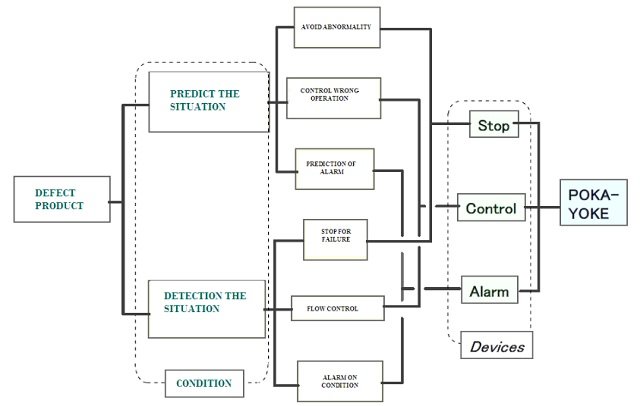
The term Poka-Yoke, translated from Japanese as “error-proofing,” is a philosophy and technique designed to minimize or eliminate human errors in processes. This methodology was introduced by Shigeo Shingo within the context of Lean Manufacturing, revolutionizing how organizations manage quality and efficiency.
Imagine a production line where a small mistake can trigger a cascade of issues, from defective products to significant financial losses. Poka Yoke addresses this reality through simple yet effective solutions that ensure operations are performed correctly from the outset. This method can be applied across various industries, including manufacturing and services (Prabowo y Aisyah, 2020).
There are many everyday examples of Poka Yoke, such as car seat belts, USB plugs that can only be inserted one way, washing machines that won’t start if the door is open, and autocorrect functions in word processors. In this article, we will delve deeply into what Poka Yoke is, its importance in industry, and how to implement it to achieve operational excellence.
What is Poka-Yoke?
Poka Yoke is a Japanese term meaning “error-proofing” or “mistake-proofing.” It is also known as “forcing function” or “behavior-shaping constraint.”
Lazarevic et al., (2019) define Poka Yoke as “a control system where errors and their propagation to the customer can be passively or actively prevented.” The main goal of Poka Yoke is to prevent human errors and defects in a process, whether by preventing them from occurring, correcting them, or signaling them immediately. Poka Yoke mechanisms are designed to eliminate errors by making it virtually impossible to commit them in a given process.
The success of Poka Yoke lies in the early detection of defects, analyzing their causes, and implementing error-proof mechanisms that minimize reliance on human skill (Biswas y Chakraborty, 2016).
Origin of Poka Yoke
The concept was formalized by Shigeo Shingo as part of the Toyota Production System (TPS) in the 1960s. Initially called “baka-yoke” (fool-proofing), it was later renamed “poka-yoke” to avoid offending workers.
Functions of Poka Yoke
- Warning Function: Alerts that an error is about to occur or has already occurred through visual, auditory, or other types of signals, such as a buzzer or light.
- Control Function: Stops a process if an error is detected or if conditions are incorrect, preventing progress until the error is corrected. For example, a machine that won’t start unless a component is properly positioned.
Benefits of Poka Yoke
The advantages of Poka Yoke span several areas, including quality, efficiency, safety, and cost. Prabowo & Aisyah (2020) emphasize the method’s influence in preventing human errors, increasing machine utilization, and reducing breakdowns and product defects. Key benefits include:
- Reduction of Errors and Defects: By eliminating errors at their source, Poka Yoke decreases defective production, improving final product quality.
- Waste Reduction: Preventing errors and defects reduces the need for rework, optimizing resource use and cutting costs.
- Shorter Training Time: Processes designed with Poka Yoke are easier to follow and harder to perform incorrectly, reducing the time needed to train workers.
- Improved Safety: Integrating Poka Yoke with safety systems prevents workplace accidents by making incorrect tool or machine use impossible.
- Increased Productivity: Fewer errors, shorter training times, and reduced rework contribute to higher process efficiency.
- Continuous Improvement: Poka Yoke fosters a culture of continuous improvement by addressing root causes of errors.
- Integrated Quality Control: Ensures quality at every stage of the process by detecting errors as they occur.
- Prevention of Defective Products: Stops defective products from reaching customers, enhancing satisfaction and reputation.
- Cost Reduction: By reducing errors, waste, and downtime, Poka Yoke significantly lowers operational costs.
Types of Poka Yoke
Poka-yoke can be classified in various ways based on their method of action and their function within the process. Here are the main types of poka-yoke according to scientific literature:
Based on the Method of Error Detection and Prevention
- Contact Method: This method detects errors by verifying the physical characteristics of the product, such as its shape, size, color, or position. Mechanisms in direct contact with the piece are used to detect deviations. For example, a sensor that verifies if a piece is correctly placed in a device or a physical guide that prevents a piece from being incorrectly positioned. This method is useful in situations involving rapid repetition, infrequent production, or adverse environmental conditions.
- Fixed Value (or Constant Number) Method: This method is used when a specific number of actions or repetitions are required to complete a task. The system alerts the operator if the correct number of movements has not been performed or if parts are missing. For instance, a counter that ensures all necessary screws have been inserted or a system that releases the exact number of parts required for an operation.
- Motion Step (or Sequence) Method: This method ensures that the steps of a process are performed in the correct order. Systems are used to verify that each step is completed before moving on to the next. For example, a digital checklist guiding the operator or a system that prevents a machine from advancing to the next step until the previous one is completed.
Based on the Function of the Poka-Yoke in the Process
- Warning Function: These poka-yokes indicate that an error is about to occur or has already occurred. They use sensory signals like lights, buzzers, visual alarms, or other cues to alert the operator to the problem. The goal is to prevent additional errors and correct existing ones.
- Control Function: These poka-yokes stop the process if an error is detected or if the conditions are incorrect. They prevent the process from continuing until the error is corrected or the required conditions are met. This method is more robust than the warning function as it ensures no further defects are generated in sequence.
It is important to highlight that poka-yoke can combine different methods and functions to enhance error prevention. The primary objective is to eliminate errors at their source to ensure quality and efficiency in processes.
Based on the Timing and Form of Application
Lazarevic et al. (2019) proposed a new classification of poka-yoke devices based on the timing and manner of their application in the workflow, summarized as follows:
- Passive Poka Yoke Devices (PPY):
These use visual or auditory warning signals to alert operators about potential errors during the process but do not prevent the errors from occurring. - Active Preventive Poka Yoke Devices (APPY):
These are used to prevent errors from occurring right at the start of the operation, ensuring that no defective products are produced. - Active Detection Poka Yoke Devices (ADPY):
These use electromechanical devices to detect defective products, preventing them from reaching customers, but corrections are still required. - Hybrid Active Preventive Poka Yoke Devices (HAPPY):
These combine passive elements (audio-visual signals) with active ones (mechanical components) to prevent errors and enhance worker efficiency. - Hybrid Active Detection Poka Yoke Devices (HADPY):
These combine passive and active elements to detect defective products.
Finally, Stadnicka y Antonelli (2024) propose a classification of poka-yoke techniques based on their function, task, goal, and effectiveness in error prevention. They use this classification to develop a Classification Chart that allows for the evaluation and prioritization of different poka-yoke techniques.
Examples of Poka Yoke in Industry
Poka-yoke devices are used in various contexts, from manufacturing to daily life. These devices are characterized by their simplicity, cost-effectiveness, and ease of implementation, focusing on the prevention or detection of errors at their source. Here are some examples of poka-yoke based on scientific literature:
Automotive Industry
- Detection of Proper Placement of a Part: During the setup of a milling machine, an optical device was introduced to detect the correct placement of an object.
- Axle Assembly: A system using logic controllers and sensors was implemented for assembling axles in two-wheeled vehicles. This system eliminates operator errors and triggers an alarm if a problem arises.
- Nut Welding: A poka-yoke template was used as a detection mechanism to prevent errors during nut welding.
- Paint Inspection: The car paint inspection process was improved using a flashing system that includes robots equipped with sensor detectors and smart cameras connected to a PC network for part tracking and color inspection.
- Molding: Pins and stoppers were used to prevent errors during the molding process at a company in Malaysia.
- Welding Fixture Deformation: A stopper was employed in a Taiwanese automotive company to address welding fixture deformation issues.
- Cylinder Variation Control: Poka-yoke was applied to control the variation of sliding cylinders at a company in India, using a digital device to measure the gap between the wheel and the product surface and an indicator to display the position of the wheel slide.
- Automotive Part Inspection: A sensor was used on an automobile shaft polishing machine to detect holes in a part.
- Welding Device: To prevent errors during the welding process in manufacturing a part called a “transport palette,” a poka-yoke device was implemented that prevents the process from continuing if the two pieces to be welded are misaligned.
Bălan y JanŃă (2019) present a methodology for applying the poka-yoke tool to solve quality issues identified within an automotive industry organization. They describe the manufacturing process of a part, analyze the operations qualitatively, and propose a poka-yoke interlock device to resolve quality issues at the workstation. The device stops the operation if a nonconformity is detected.
Logistics
- Wireless Scanning Devices:
These devices halt the process if an incorrect shipment is selected, eliminating human errors. - Assembly:
Poka-yoke devices controlled by programmable logic controllers are used to support operators during assembly processes.
Construction Industry
Poka-yoke devices can be useful for safety reasons, although they have limited impact on variability.
Software and Services
- Diagnostic Systems:
Computer diagnostic systems, limit switches, and motion step poka-yoke devices alert vehicle recovery specialists.
Healthcare
- Medication Administration:
Pre-filled syringes and single-dose pillboxes are used to prevent errors in medication administration. - Patient-Specific Safety Measures:
A blood lock that only works with the patient’s wristband code and automatic wheelchair brakes are examples of error-proof mechanisms.
People with Disabilities
- A poka-yoke controller was designed to improve weighing and counting processes for individuals with cognitive disabilities, using software with weighing, counting, and sensor modes.
These examples illustrate the versatility of poka-yoke devices and their adaptability to different contexts to enhance work quality and safety. Poka-yoke devices are characterized by their simplicity, cost-effectiveness, and focus on error prevention or detection at their source.
Poka Yoke in Lean Manufacturing: Error Prevention and Continuous Improvement
Poka Yoke is a cornerstone of Lean Manufacturing, a methodology aimed at eliminating waste and optimizing processes. Human nature is prone to making mistakes due to fatigue, distraction, or lack of knowledge.
Husár et al., (2023) demonstrated how lean production tools and the Poka Yoke method can effectively develop smart manufacturing enterprises.
Fundamental Principles
- Prevention Before Correction: Poka Yoke focuses on detecting errors before they occur, minimizing their negative impact on production.
- Simplicity in Design: Solutions must be intuitive and easy to implement.
Relationship with “Waste”
Poka Yoke aligns with Lean principles, helping eliminate defects, rework, and downtime, three of the most costly forms of waste in production. A classic example is the design of electrical connectors that only fit one way, preventing assembly errors.
Poka Yoke and Six Sigma
Poka Yoke complements Six Sigma, a methodology aimed at minimizing variation and defects in processes.
How They Integrate:
- Six Sigma uses data and analysis to identify problem areas.
- Poka Yoke implements practical solutions to prevent defects.
Together, they form a powerful combination to enhance quality at all levels.
Poka Yoke and FMEA
Poka Yoke and FMEA (Failure Mode and Effects Analysis) are complementary tools that significantly improve product and process quality by eliminating errors and defects (Puvanasvaran et al., 2014). Integrating Poka Yoke into FMEA guides engineers toward appropriate actions and controls for each potential failure.
- FMEA predicts and prevents problems through proper controls or detection methods.
- Poka Yoke focuses on detecting and correcting errors before they become defects.
How to Implement a Poka Yoke System: Step-by-Step
Implementing a Poka Yoke system requires analysis, creativity, and a systematic approach to identify and prevent errors. Here are the key steps and considerations:
Process Analysis
- Create or Obtain a Process Flowchart: Understand the process to be improved by creating or analyzing a detailed flowchart to identify each step and potential failure points.
- Identify Error Points: Analyze each step to detect where and when human errors are most likely. Pay special attention to processes relying on attention, skill, or experience, and handoffs between workers. Also, consider errors that could cause significant downstream issues.
Root Cause Identification
- Determine the Source of the Error: Investigate the root cause of each potential error to develop solutions addressing the problem’s origin and prevent recurrence.
Selecting a Poka Yoke Strategy
- Consider Elimination, Replacement, and Facilitation Methods:
- Elimination: Remove the error-causing step by redesigning the product or process.
- Replacement: Substitute the step with an error-proof alternative.
- Facilitation: Make the correct action easier than the incorrect one.
- Use Detection and Mitigation Methods:
- Inspection Methods: Implement successive, self-inspection, or source inspection to catch errors early.
- Setting Functions: Use contact methods, fixed-value methods, or motion-step methods to inspect product parameters.
- Regulating Functions: Use warning signals (alarms, lights) or control functions (process halts) to signal errors.
Design and Implementation
- Choose Appropriate Devices or Methods:
- Contact Method: Employ physical guides, contact sensors, or systems detecting physical characteristics of a piece.
- Fixed-Value Method: Use counters or systems ensuring a specific number of actions.
- Motion-Step Method: Use checklists or digital systems guiding operators through the process steps.
- Create Simple, Cost-Effective Designs: Poka Yoke devices should be simple, low-cost, and easy to maintain. Integrate them into the process near the error point for immediate response.
- Incorporate Poka Yoke Into the Process: Ensure mechanisms simplify rather than complicate the process, making correct actions easier.
- Use Creative, Low-Cost Solutions: Innovate to prevent errors without requiring significant investment, blending science and art.
Evaluation, Testing, and Adjustments
- Evaluate Devices and Methods: Saurin et al., (2012) proposed a framework to evaluate Poka Yoke devices (PDs), focusing on design, operation, and maintenance processes rather than just outcomes. The framework includes attributes for fail-safe characteristics:
- FS1: Poka Yoke has both a control function and a highly visible warning function.
- FS2: Used for source inspection.
- FS3: Inspects 100% of parts for all product models.
- FS4: Operates without specific actions by the operator for this purpose.
- FS5: Does not create new opportunities for unintentional errors.
- FS6: Does not endanger workers’ health or safety.
- FS7: Maintenance plans include periodic calibration or replacement if necessary.
- FS8: Maintenance plans verify effectiveness at the start of each shift.
- Follow Best Practices: Incorporate best practices for design, implementation, and maintenance:
- BP1: Formal criteria for selecting operations needing Poka Yoke.
- BP2: Cost-benefit analysis during design; real-scale performance matches expected benefits.
- BP3: Designed by a cross-functional team (e.g., quality reps, frontline operators).
- BP4: Documentation detailing Poka Yoke’s functionality is available at the workstation.
- BP5: Dedicated area for storing defective parts identified by Poka Yoke.
- BP6: Standardized visual aids (e.g., posters) identify Poka Yoke operations.
- BP7: Historical records of corrective and preventive maintenance.
- Test Devices and Methods: After implementation, test the Poka Yoke system and adjust as needed. Ensure it reduces errors effectively and operates as expected.
Monitoring and Continuous Improvement
Measuring Effectiveness: Continuous tracking of key performance indicators, such as error rates, product quality, and production efficiency, is essential to evaluate the effectiveness of the poka-yoke system.
Maintaining and Continuously Improving: Poka-yoke is an ongoing process. Processes and devices must be maintained and improved over time, adapting to changes and identifying new opportunities for enhancement.
Additional Considerations
- Engage the Right People: Bring together individuals involved in the process, including operators and poka-yoke experts, to discuss and analyze the process.
- Avoid Blaming Operators: Instead of blaming operators for errors, focus on finding solutions that prevent errors through process design.
- Training and Communication: It is crucial to train workers on the use and purpose of poka-yoke systems and to communicate any changes or improvements to the processes.
By following these steps, companies can implement effective poka-yoke systems that reduce errors, improve quality, increase efficiency, and create safer work environments. The goal is to make processes as error-proof as possible, leveraging creativity and innovation for continuous improvement.
The Future of Poka-Yoke: Automation and Technology
With advancements in automation and artificial intelligence, poka-yoke is evolving toward more sophisticated solutions:
- IoT Sensors: Monitoring processes in real-time.
- Machine Vision Systems: Detecting defects with high precision. Martinelli et al., (2022) implemented an intelligent poka-yoke system based on machine vision, which proved to be an effective and low-cost solution for preventing assembly errors. This led to a significant increase in productivity and improved final product quality.
- Predictive Analytics Platforms: Anticipating problems before they occur.
In this regard, Lv et al., (2022) integrated equipment failure into poka-yoke technology and designed a fault detection and elimination algorithm based on active learning with digital twins. Similarly, Widjajanto et al., (2020) and Wolniak (2024) emphasize that the poka-yoke method and Industry 4.0 (I4.0) can complement each other. I4.0 offers new tools that enhance the effectiveness of poka-yoke in error prevention.
Conclusion
Poka-yoke is not just a technique for error prevention; it is a philosophy that fosters operational excellence and respect for people. By implementing this methodology, organizations can achieve new levels of quality, productivity, and customer satisfaction.
Now more than ever: Are you ready to integrate poka-yoke into your organization? The results are worth it.
References
Bălan, E., & JanŃă, L. M. (2019). SOLVING QUALITY PROBLEMS WITH THE POKA-YOKE TOOL ASSISTANCE. CASE STUDY. Annals of the Academy of Romanian Scientists Series on Engineering Sciences, 11(1), 5.
Biswas, A. C., & Chakraborty, A. (2016). Using Poka-Yoke for the development of SMEs. American Journal of Engineering Research (AJER), 5(9), 15-18.
Husár, J., Hrehova, S., Trojanowski, P., Wojciechowski, S., Kolos, V. (2023). Perspectives of Lean Management Using the Poka Yoke Method. In: Ivanov, V., Trojanowska, J., Pavlenko, I., Rauch, E., Pitel, J. (eds) Advances in Design, Simulation and Manufacturing VI. DSMIE 2023. Lecture Notes in Mechanical Engineering. Springer, Cham. https://doi.org/10.1007/978-3-031-32767-4_12
Lazarevic, M., Mandic, J., Sremcev, N., Vukelic, D., & Debevec, M. (2019). A systematic literature review of Poka-Yoke and novel approach to theoretical aspects. Strojniski Vestnik/Journal of Mechanical Engineering, 65(7-8), 454-467.
Lv, Z., Guo, J., & Lv, H. (2022). Safety poka yoke in zero-defect manufacturing based on digital twins. IEEE transactions on industrial informatics, 19(2), 1176-1184.
Martinelli, M., Lippi, M., & Gamberini, R. (2022). Poka Yoke Meets Deep Learning: A Proof of Concept for an Assembly Line Application. Applied Sciences, 12(21), 11071. https://doi.org/10.3390/app122111071
Prabowo, R. F., & Aisyah, S. (2020). Poka-Yoke Method Implementation in Industries: A Systematic. IJIEM (Indonesian Journal of Industrial Engineering & Management) Vol 1 No 1 February 2020, 12-24
Puvanasvaran, A. P., Jamibollah, N., & Norazlin, N. (2014). Integration of poka yoke into process failure mode and effect analysis: A case study. American Journal of Applied Sciences, 11(8), 1332.
Saurin, T. A., Ribeiro, J. L. D., & Vidor, G. (2012). A framework for assessing poka-yoke devices. Journal of Manufacturing Systems, 31(3), 358-366. https://doi.org/10.1016/j.jmsy.2012.04.001
Stadnicka, D., & Antonelli, D. (2024). Classification Graph of Poka-Yoke Techniques for Industrial Applications: Assembly Process Case Studies Effectiveness Evaluation. Technologia i Automatyzacja Montazu (Assembly Techniques and Technologies), 124(2), 18-28.
Widjajanto, S., Purba, H. H., & Jaqin, S. C. (2020). Novel POKA-YOKE approaching toward industry-4.0: A literature review. Operational Research in Engineering Sciences: Theory and Applications, 3(3), 65–83. https://doi.org/10.31181/oresta20303065w
Wolniak, R. (2024). The usage of Poka-Yoka in industry 4.0 conditions. Zeszyty Naukowe. Organizacja i Zarzadzanie/Politechnika Slaska.
Editor and founder of “Innovar o Morir” (‘Innovate or Die’). Milthon holds a Master’s degree in Science and Innovation Management from the Polytechnic University of Valencia, with postgraduate diplomas in Business Innovation (UPV) and Market-Oriented Innovation Management (UPCH-Universitat Leipzig). He has practical experience in innovation management, having led the Fisheries Innovation Unit of the National Program for Innovation in Fisheries and Aquaculture (PNIPA) and worked as a consultant on open innovation diagnostics and technology watch. He firmly believes in the power of innovation and creativity as drivers of change and development.





